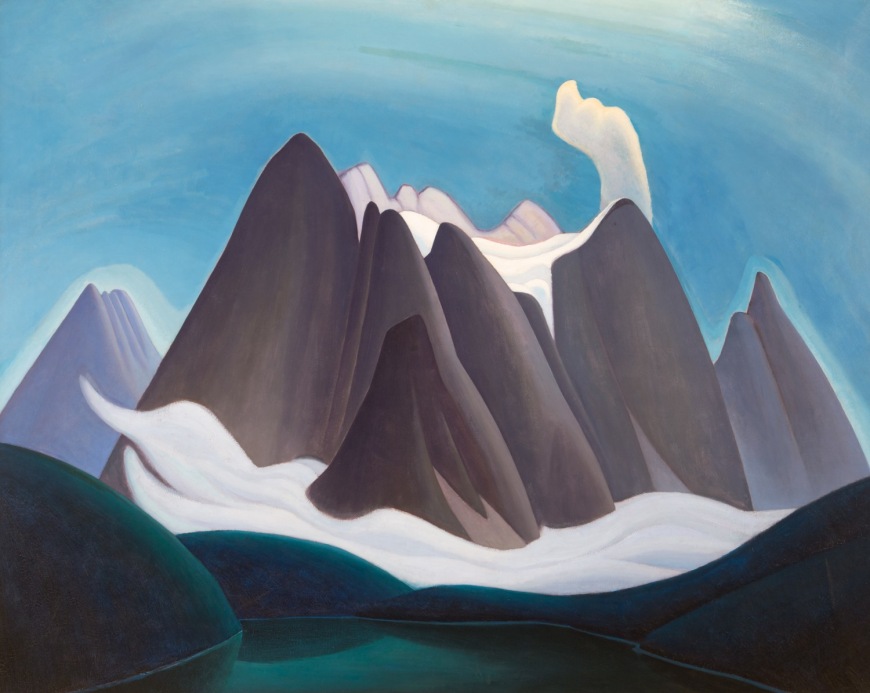-
Œuvres d'art
Lawren S. HarrisMountain Form IV (Rocky Mountain Painting XIV), 19271885-1970Oil on canvas48 x 60 in
121.9 x 152.4 cmSoldProvenance
The Art Emporium, Vancouver;
Acquired from the above by Mitzi and Mel Dobrin.Expositions
Toronto, Art Gallery of Toronto, April 1930, Exhibition by the Group of Seven, no. 45 as Mountains, Moraine Lake, Alberta [?]
Toronto, Alan Klinkhoff Gallery, Lawren Harris & Canadian Masters: Historic Sale Celebrating Canada's 150 Years, April 1, 2017.Documentation
The paintings of Lawren Harris compiled by Mrs. Gordon Mills, July-December 1936, as Rocky Mountain Paintings XIV, Mountain Forms IVLe texte complet portant sur cette oeuvre n'est disponible qu'en anglais seulement. Nous vous remercions de votre compréhension.
Pour obtenir davantage de renseignement, nous vous encourageons à communiquer avec nous.
In August 1932 Lawren Harris wrote to Thoreau MacDonald at the Studio Building in Toronto from Canoe Lake in Algonquin Park, where he was holidaying with his family. He asked Thoreau to bring out a “mountain canvas of Moraine Lake (48 x 60”)” for an exhibition going to the United States. He enclosed a rough drawing of the canvas which was In the Mountains (Rocky Mountain Painting IX), now in the Thomson collection at the Art Gallery of Ontario as Untitled Mountain Landscape (fig. 1). That canvas, for which there is a sketch in the Robert McLaughlin Gallery in Oshawa titled Mountains, Moraine Lake, is a variant of Mountain Forms IV (Rocky Mountain Painting XIV).
.

(Fig. 1) In the Mountains (Mountain Painting IX), c. 1927-1930, oil on canvas 48 x 60 in. (121.9 x 152.4 cm.) Art Gallery of Ontario, The Thomson Collection
It is not clear which of the two canvases, both identical in size, was shown in the April 1930 Group of Seven exhibition as Mountains, Moraine Lake, Alberta but they differ considerably. In both canvases the mountains, identified by Lisa Christensen, author of A Hiker’s Guide to the Rocky Mountain Art of Lawren Harris, as The Ten Peaks above Moraine Lake, occupy the centre of the composition and rise from the water in the foreground. Clouds play above the snowy, cupped peaks. The light and movement of clouds among the mountain peaks were a subject that Harris treated in several canvases including one Emily Carr saw in Harris’ studio in December 1927 and about which she wrote in her journal. “The great mountain with the swirling shaft of cloud leaping from the crater is beautiful, but the cloud is not compatible yet.” In Lake and Mountains (Rocky Mountain Painting V) of 1928 in the Art Gallery of Ontario, hard edged, dramatic pointed clouds, reaching like fingers over the central peaks, are a visually dominant motif. And in In the Mountains (Mountain Painting IX) transparent, billowing clouds form a backdrop behind the mountains and a very solid, sharply pointed cloud obtrusively enters upper left. Hard-edged shafts of light shine down from the top centre illuminating the mountains and lake which is framed by green shoreline rises. Mountain Form IV (Rocky Mountain Painting XIV) is a much more lyrical painting. Elegant drifting clouds play about the base and a gently curving cloud rises up from the mountain’s crater. The central mountains are cradled by the lake, the rising cliffs in the foreground and by adjacent peaks centre right and left. The light is luminous, vibrating around the side peaks and illuminating the bowl and clouds. This painting was stored at the Art Gallery of Toronto when Harris moved to New Hampshire in 1934 and remained with the artist into the 1960s. It was inventoried in the trust collection of his paintings Harris established in 1964 as LSH Holdings Ltd. number 191.
Charles C. Hill, C.M. From Lawren Harris & Canadian Masters, Alan Klinkhoff Gallery, 2017
Charlie Hill began working at the National Gallery of Canada in 1972 and was Curator of Canadian Art from 1980 to 2014. The exhibitions he organized and publications he wrote include “Canadian Painting in the Thirties” (1975), “To Found a National Gallery. The Royal Canadian Academy of Arts 1880-1913” (1980), “Morrice A Gift to the Nation The G. Blair Laing Collection” (1992) and “The Group of Seven Art for a Nation” (1995). He was co-curator and contributed essays to the catalogues of “Tom Thomson” (2002), “Emily Carr A New Perspective” (2006) and “Artists, Architects, Artisans Canadian Art 1890 - 1918” (2013). He was appointed a Member of the Order of Canada in 2000, received an Honorary Doctorate from Concordia University in 2007 and the Award of Distinguished Service from the Canadian Museums Association in 2012.
12sur 12





